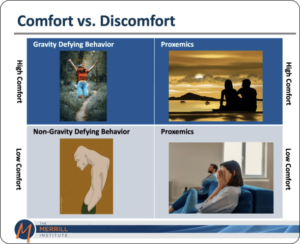Non-verbal communication is more honest than words.

The words people use can often be misleading, especially in the workplace. As leaders we need to know if our teams are feeling good about and are aligned with a project or if a job candidate is comfortable with the requirements of a position. The words people use can often communicate what they think we want to hear, but their non-verbal communication is much harder to control and can provide helpful hints about their true feelings.
There are lots of misconceptions about body language out there, but David M. Schneer, CEO of The Merrill Institute for Nonverbal Intelligence, shared some scientifically studied micro-expressions with our members and how they can be used to gain insight into people’s true feelings.
What is a micro-expression? These are universal, involuntary facial movements that indicate emotional states such as happiness, sadness, contempt, disgust, fear, surprise, or anger. And, of course, the neutral state. If you’re human you will exhibit these facial micro expressions under certain circumstances.
Clusters and Context Are The Key
It’s important to look for multiple micro-expressions surrounding a stimulus (i.e., a question, image, etc.) that tell the same story when evaluating non-verbal communication. A single micro-expression is insufficient to read emotions, and is tantamount to reading a single chapter of a book. You want to look for other signs that support or refute that non-verbal statement to understand how someone is really feeling over the course of your interaction.
Feet Don’t Lie
Our feet are the most honest part of our body because they are instinctively always pointed to where we want to go. If you’re talking to someone and their feet are pointed away from you (or toward the exit) they are telling you that they want to leave. This can mean that they are uncomfortable with what you are saying. So, what do you do? Perhaps consider asking them follow-up questions to gauge their interest or to help identify and address their concerns. Glass desks or conference tables with swivel chairs will help you read people's feet even when they are sitting down.

Signs of Comfort Defy Gravity
People naturally seek comfort and it’s a key component of happiness. If someone is exhibiting signs of comfort, they are showing you that they are receptive to what you are saying and more likely to support or agree with you. Look for gravity-defying behavior and proximity as indicators of comfort.

Close Proximity
If someone is leaning toward you or close to you it’s a good sign.
Creating Space
When a person moves away, either by leaning back, pushing their chair back or sitting further away from you it’s a sign they are uncomfortable.
Jumping
You’ve heard the expression “jumping for joy,” and while it’s unlikely to see jumping in a meeting it’s usually a good sign.
Slouching
When the shoulders, mouth or eyebrows are down so are their feelings.
Other signs of comfort or discomfort included, but are not limited to, the following:
Genuine Smiles
Smiles are easy to fake but the real thing is the equivalent of the mouth jumping. Look at the corners of the mouth to see if they are symmetrically raised and that the eyes are squinted slightly, forming the “crow’s feet”--both together are signs of a genuine smile.

Head Tilts
If you have a dog you’re probably seen this behavior before, and like dogs, people will tilt their heads slightly when they are comfortable and engaged with you.
Interlaced Hands
Tight, interlaced fingers and white knuckles are not a good sign..
Facial Denting
Using a finger or a pen to push parts of the face is a way of pacification and a sign of stress.

Pressed Lips
When people press their lips together it’s often a sign of stress.
Asymmetrical Movements
Whether it’s a smile or a shoulder shrug, asymmetrical movements are often a sign that something is amiss.

See Something, Say Something
If you see signs of discomfort, create an opportunity to alleviate it through conversation.
“I’d love to hear any thoughts or concerns you have with this plan.”
“Are there any aspects of this that concern you?”
“Are there other considerations I should be taking into account?”
“Let’s take a walk.”
Non-threatening questions and “I” statements can help people verbalize their feelings and put you on the path to resolution.
There are numerous other indicators of peoples’ emotions that are reliable indicators of how they are feeling. The indicators discussed in this blog are but a few of the more common ones. We hope that this introduction will help you to start identifying and deciphering what people’s bodies are really telling you.